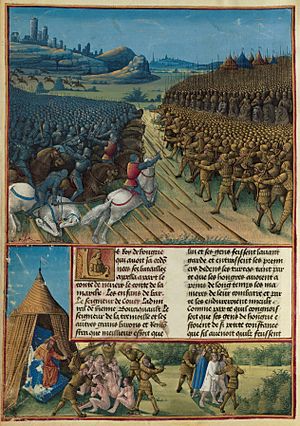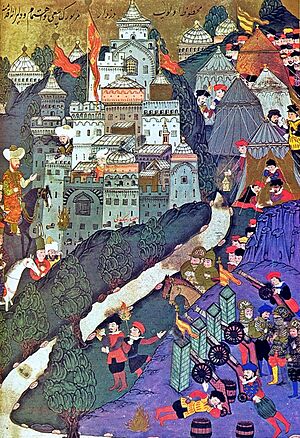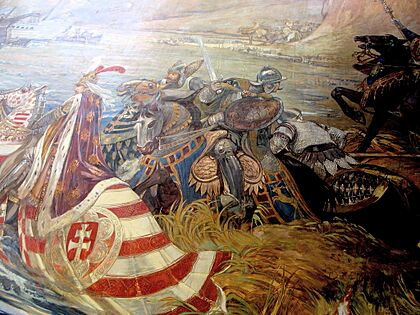Battle of Nicopolis facts for kids
Quick facts for kids Battle of Nicopolis |
|||||||||
|---|---|---|---|---|---|---|---|---|---|
| Part of the Ottoman wars in Europe and the Crusades |
|||||||||
 Miniature by Jean Colombe (c. 1475) |
|||||||||
|
|||||||||
| Belligerents | |||||||||
|
Ottoman Empire
Moravian Serbia |
Crusade:
|
||||||||
| Commanders and leaders | |||||||||
| Stefan Lazarević |
|
||||||||
| Strength | |||||||||
| 10,000–20,000 | 17,000–20,000 | ||||||||
| Casualties and losses | |||||||||
| Considerable Ottoman losses |
|
||||||||
The Battle of Nicopolis was a huge fight that happened on September 25, 1396. It was a major battle between a Christian Crusader army and the Ottoman forces. The Crusaders were trying to capture the fortress of Nicopolis on the Danube River. However, the Ottomans won a big victory. This battle is sometimes called the Crusade of Nicopolis because it was one of the last big Crusades in the Middle Ages. After this win, the Ottomans became even stronger in the Balkans and were a bigger threat to Europe.
Contents
Why the Battle Happened
Rising Ottoman Power
In the 1300s, there were many smaller Crusades. But most of them didn't achieve their goals. The Ottoman Empire was growing very powerful. They had taken over most of the Balkans region. They even surrounded Constantinople, the capital of the Byzantine Empire.
In 1393, the Ottomans captured Nicopolis from the Bulgarian ruler, Ivan Shishman. Other Balkan leaders saw this as a chance to fight back. They wanted to take their lands from Ottoman control.
Hungary's Fear and Trade Concerns
The Kingdom of Hungary was next in line to be attacked by the Ottomans. They were the main Christian country in Eastern Europe facing this threat. The Republic of Venice and the Republic of Genoa were also worried. They were important trading cities. Ottoman control of the Balkans would hurt their trade routes. They feared losing their influence over the seas and trade with the Black Sea.
A Call for a New Crusade
In 1394, Pope Boniface IX called for a new crusade. Even though the Church was divided at the time, many European nobles were excited. They saw it as a chance to gain glory and power.
Two main things helped this crusade happen. One was a break in the Hundred Years' War between England and France. The other was the support of Philip II, the Duke of Burgundy. He was a very powerful French noble. He wanted to increase his family's fame and power. He spent a lot of money to prepare for the crusade.
In 1395, King Sigismund of Hungary asked France for help. He described how the Ottomans were harming Christian lands. King Charles VI of France agreed to help. Many French nobles eagerly joined. They felt it was their duty to protect Christianity.
How Many Soldiers Fought
It's hard to know exactly how many soldiers fought at Nicopolis. Old stories often give very large numbers, like 400,000. Each side wanted to say the enemy was bigger. This made their victory seem greater or their defeat less shameful.
Historians today think the numbers were much smaller. It would have been impossible to feed so many soldiers and horses in that area. One person who was there, Johann Schiltberger, said there were about 17,000 Crusaders. He thought there were 200,000 Turks, which was probably too high.
Here's a table with some estimates:
| Source | Year | Affiliation | No. of crusaders | No. of Turks | Total no. | Cite |
|---|---|---|---|---|---|---|
| Johann Schiltberger | 1427 | European | 16,000 | 200,000 | 216,000 | |
| Şükrullah in his Behçetu't-Tevârih | 1460s | Ottoman | 130,000 | 60,000 | 190,000 | |
| German historians of the 19th c | 19th century | European | 7,500–9,000 | 12,000–20,000 | 19,500–29,000 | |
| David Nicolle | 1999 | European | 16,000 | 15,000 | 31,000 |
Crusader Army Makeup

The Crusader army was made up of soldiers from many different places. About 11,000 men came from France, including knights, squires, archers, and foot soldiers. The Knights Hospitaller from Rhodes also joined. They were a military order of knights.
Venice sent a navy to help. Hungarian messengers encouraged German princes to join. Knights from Poland, Bohemia, Navarre, and Spain also came.
Some old reports said 3,000 English knights joined. However, there's no real proof of this. Most English nobles were busy with the King's wedding at the time. It's more likely that some English Knights Hospitaller were present.
Overall, the Crusader army might have been around 17,000 to 20,000 soldiers. Some sources say up to 49,000, or even 130,000.
Ottoman Army Makeup
The Ottoman army is thought to have had between 15,000 and 20,000 soldiers. Some sources claim up to 60,000. The Ottoman force also included 1,500 Serbian heavy cavalry knights. These knights were led by Prince Stefan Lazarević. He was the brother-in-law of Sultan Bayezid I and his ally.
The Journey to Battle
Heading to Buda

The Crusader army left Dijon, France, on April 30, 1396. They traveled through Bavaria and then used boats on the upper Danube River. Their goal was to meet King Sigismund in Buda, Hungary.
Their plan was to drive the Ottomans out of the Balkans. Then, they hoped to help Constantinople. After that, they dreamed of marching through Turkey and Syria to free Palestine. They wanted to reach the Church of the Holy Sepulchre.
A fleet of Venetian ships was supposed to block the Ottomans at sea. They would also sail up the Danube to meet the Crusaders.
The French leaders, including John, Count of Nevers, took their time. They stopped for many parties and celebrations. This delayed their arrival in Buda until July.
From Buda to Nicopolis

Once the leaders met in Buda, they held a war council. King Sigismund suggested waiting for the Ottomans to come to them. He thought it was smarter to let the Turks march a long way. But the French knights disagreed. They wanted to attack right away. They felt it was more honorable to seek out the enemy.
The Crusaders then marched down the Danube River. As they entered Ottoman lands, they reportedly took supplies from the local people. Some historians say the French soldiers were very undisciplined.
At Orşova, the army crossed the Danube. Their first target was Vidin, a city controlled by the Ottomans. The ruler of Vidin surrendered quickly. The Crusaders executed the Turkish officers there. This made the French even more confident.
Next, they attacked Oryahovo (Rachowa), a strong fortress. The French rushed ahead to attack it first. They managed to get to the walls. The next morning, the people of Oryahovo agreed to surrender to Sigismund. They were promised their lives and property would be safe. However, the French broke this promise. They looted the town and killed many people. This angered the Hungarians.
After leaving a small group to hold Oryahovo, the Crusaders continued. They attacked a few more places along the way. But they also missed one fort. Messengers from that fort escaped to tell Sultan Bayezid about the Christian army. On September 12, the Crusaders finally saw the fortress of Nicopolis.
Siege of Nicopolis
Nicopolis was a very strong fortress. It was built on a high cliff near the Danube. It had two walled towns, one high up and one below. The Turkish governor, Doğan Bey, was ready for a long siege. He was sure Sultan Bayezid would come to help.
The Crusaders had not brought any siege machines. They thought they could just use ladders and courage. But the walls were too strong and the slope too steep. Taking the castle by force was impossible. So, the Crusaders surrounded the town. They blocked all exits and used their ships to stop supplies from coming by river. They planned to starve out the defenders.
The Crusaders were very confident. They spent two weeks feasting and playing games. They didn't even post many guards. Some scouts brought news that the Turks were coming. But the French leaders didn't believe it. They thought it was a trick. One French leader even threatened to punish anyone who talked about the Turks approaching.
Only de Coucy took scouting seriously. He led a group of knights south. They found a large group of Turks. De Coucy's men set up an ambush and defeated them. This action woke up the Crusader camp. But it also made the French even more overconfident. It also made another French leader, D'Eu, jealous.
On September 24, Sigismund called a war council. He and Mircea of Wallachia suggested a plan. They wanted the Wallachian foot soldiers to attack first. These soldiers knew how to fight the Turks. They would wear out the first line of Turkish soldiers. Then, the French knights would charge. The Hungarians and other allies would follow to support them.
But D'Eu strongly disagreed. He said it was an insult for knights to follow foot soldiers. He insisted that the French knights should lead the charge. Other young French knights supported him. Nevers, the overall commander, was convinced by their confidence.
Sigismund left to plan for his own forces. Soon after, he sent word that Bayezid was only six hours away. The Crusaders were confused and panicked. Some still didn't believe it. At this point, the prisoners taken at Oryahovo were killed. Even European writers later called this a cruel act.
The Battle Begins
At dawn on September 25, the armies got ready. Sigismund sent a message to Nevers. He asked to delay the attack for two hours. He wanted his scouts to get more information about the Turkish army. Nevers held a quick meeting. De Coucy and Jean de Vienne, an older French knight, agreed with Sigismund. They thought it was a wise idea.
But D'Eu again spoke up. He said Sigismund just wanted all the glory for himself. He insisted on leading the charge right away. De Coucy called D'Eu's words "presumptuous." Vienne said that if D'Eu wanted to go, the army must follow. But he still thought it was better to wait for the Hungarians. D'Eu refused to wait. The argument became heated. The younger knights accused the older ones of being afraid. D'Eu decided to attack.
D'Eu led the first group of French knights. Nevers and de Coucy commanded the main group. The French knights, with their archers, rode towards the Turks. The Turks were coming down the hills. The Knights Hospitaller, Germans, and other allies stayed with Sigismund's Hungarian forces.
The French charge was powerful. They broke through the first line of Turkish soldiers. But the knights faced many archers. They also ran into rows of sharpened stakes. These stakes were designed to hurt their horses. Many knights had to get off their horses to pull up the stakes. The French eventually defeated the first group of Turkish foot soldiers.
De Coucy and Vienne suggested that the French stop. They wanted them to rest and regroup. They also wanted to wait for the Hungarians to join them. But the younger knights refused. They thought they had already defeated Bayezid's whole army. They insisted on chasing the fleeing Turks.
So, the French knights continued up the hill. Many were now on foot because of the stakes. They were struggling in their heavy armor. When they reached the top, they expected to find more fleeing Turks. Instead, they faced a fresh group of Turkish cavalry, called sipahis. Bayezid had kept these soldiers hidden.
The sipahis charged forward. They blew trumpets and shouted. The French knights realized how bad their situation was. Some knights fled back down the hill. The rest fought bravely. Admiral de Vienne, who carried the French flag, was wounded many times. He tried to rally his men but was struck down. Many other important knights were killed or captured. The Turks surrounded Nevers. His bodyguards surrendered to save his life. Nevers was taken prisoner. Seeing this, the rest of the French gave up.
While the French were fighting on the hill, Turkish cavalry swept around their sides. The Hungarians and other allies were fighting on the plain. Many riderless horses ran by. This made the Transylvanians and Wallachians think the battle was lost. They left the field.
Sigismund, the Master of Rhodes, and the Germans fought hard. But they were overwhelmed. Then, 1,500 Serbian knights joined the Turks. This was a critical moment. Sigismund was convinced to escape. He and the Master got away on a fisherman's boat to Venetian ships on the Danube. Sigismund's army surrendered. The Crusaders were completely defeated.
Aftermath
Captives and Ransom
Few of those who fled the battle survived. Many tried to swim to the boats in the Danube. Some boats sank because too many people tried to get on. Many drowned trying to swim across the river. Sigismund sailed to the Black Sea and Constantinople to get home safely.
Those who made it across the Danube and tried to walk home faced great hardship. The land had already been stripped of food by the retreating Wallachians. Many starved and died along the way.
The captured nobles were forced to march 350 miles to Gallipoli. They were stripped of their clothes and beaten. At Gallipoli, the nobles were kept in a tower. Other prisoners were kept below. Sigismund's ship passed by the tower. The Turks made the prisoners stand on the shore and mocked Sigismund. After two months, the prisoners were moved to Bursa, an Ottoman city. They waited there for news of their ransom.
In December, news of the defeat reached Paris. It was a huge shock. The King and other nobles sent messengers to find out what happened. On Christmas, a knight named Jacques de Helly arrived in Paris. He had been sent by Bayezid. He told the King about the battle and the defeat. He also brought letters from Nevers and other captured nobles. Everyone who didn't get a letter was assumed dead. January 9 was declared a day of mourning in France.
A group with rich gifts left Paris in January 1397 to negotiate the ransoms. Gian Galeazzo Visconti, the Duke of Milan, helped a lot. He had many contacts in the Ottoman court.
Sadly, de Coucy died in February 1397. Other nobles also died while trying to get home or raise money. The French negotiators finally agreed on a ransom of 200,000 gold coins in June. With a first payment, the prisoners were released on June 24. They promised to stay in Venice until the rest of the money was paid.
The last Crusader leaders returned to France in February 1398. They were met with celebrations and parades.
Long-Term Effects
The Battle of Nicopolis was a huge defeat for Western Europe. After this, Europe didn't try to stop the Turkish advance in the Balkans for a long time. England and France soon went back to fighting each other.
The Ottomans continued to grow stronger. Sultan Bayezid I was later defeated by Timur (Tamerlane) in 1402. This gave some European leaders a chance to fight back. But the Hungarians, Poles, and Wallachians were defeated again at the Battle of Varna in 1444.
Finally, Constantinople fell to the Turks in 1453. This marked the end of the Byzantine Empire. The Battle of Nicopolis is also seen as the end of the Second Bulgarian Empire. Hopes for its return ended with the Crusader defeat. Its last ruler, Ivan Sratsimir of Bulgaria, was captured and killed.
The Ottoman victory at Nicopolis discouraged future European groups from forming against them. The Ottomans kept up their pressure on Constantinople. They tightened their control over the Balkans. They became an even greater threat to Central Europe.
See also
- Leonhard Reichartinger
|



